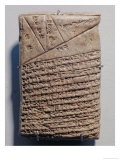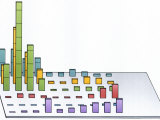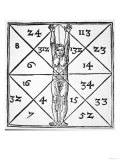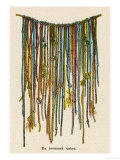|
|
|
|
|
A number symbol or numeral, (0,1,2,3,4,5,6,7,8,9), also called ‘glyphs’, evolved from ancient Brahmi numerals and were introduced to Western Europe by Arab scholars.
Numberal symbols are used to describe a count, measurement, calculate, label an object, and create codes in describing mathematical concepts of
- quantity,
- order,
- structure,
- space,
- change, and
- pattern (repetition and variations).
The word mathematics is from the Greek meaning learning and study. In arithmetic, the oldest branch of mathematics, numbers are used in the operations of
- addition (+),
- subtraction (-),
- multiplication (x) and
- division (÷).
Other branches of medieval mathematics were geometry (literally measure the Earth) for spatial relationships, music (harmonics), and astronomy.
|
|
click on image for details and to enlarge.
|
|
|
|
Set of 4 posters: Conversion, Length, Mass, Volume, with reproducible activity sheets and teacher's guide for a clear understanding of the metric system, the measurement system used throughout much of the world.
• more science posters
|
|
|
|
Zero - Nine, 1958/59
Art Print, Jasper Johns
|
|
|
|
|
|
|
An abacus is an ancient calculation tool consisting of a frame with beads on wires.
Abacus', in use prior to the adopiton of written numerals, is still widely used in Asia and Africa.
• Napier's “Bones” posters
|
|
|
|
The cuneiform (q-knee-a-form), a script that gets its name from the wedge shaped impressions left by a reed stylus in a clay tablet (L. cuneus = wedge), is one of the earliest known writing systems.
Over the course of several thousand years the pictograph system devised by the Sumerian (c. 3000 BC), was simplified and abstracted. In due course cuneiform was adapted by many cultures and inspired national alphabets. Cuneiform was gradually supplanted by Aramaic.
• math
• Sumerian - Ancient Civilization poster
• Middle East posters
|
|
|
|
|
|
|
|
|
|
|
|
|
|
|
|
Quipu (Spanish spelling), a recording devices used by the Inca, usually consisted of colored spun and plied threads from llama or alpaca hair or cotton cords with knots that encoded tax, census and events data. The knots seem to represent a base 10 positional system. Some kuipu (kuipu is word for “knot” in Quechua, the native Inca language) may have just a few strands, others have up to 2,000 strands.
North American indigenous peoples' wampum, usually thought of as a medium of exchange, or currency, was also used in a similar way.
|
|
|
previous page | top
|
|
I have searched the web for visual, text, and manipulative curriculum support materials - teaching posters, art prints, maps, charts, calendars, books and educational toys featuring famous people, places and events - to help teachers optimize their valuable time and budget.
Browsing the subject areas at NetPosterWorks.com is a learning experience where educators can plan context rich environments while comparing prices, special discounts, framing options and shipping from educational resources.
Thank you for starting your search for inspirational, motivational, and educational posters and learning materials at NetPosterWorks.com. If you need help please contact us.
|
|
|


























